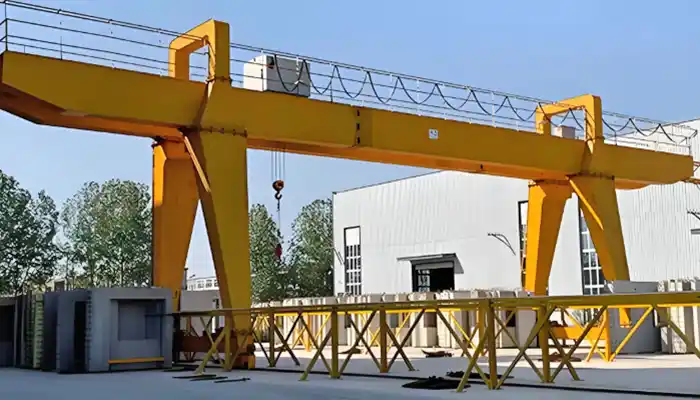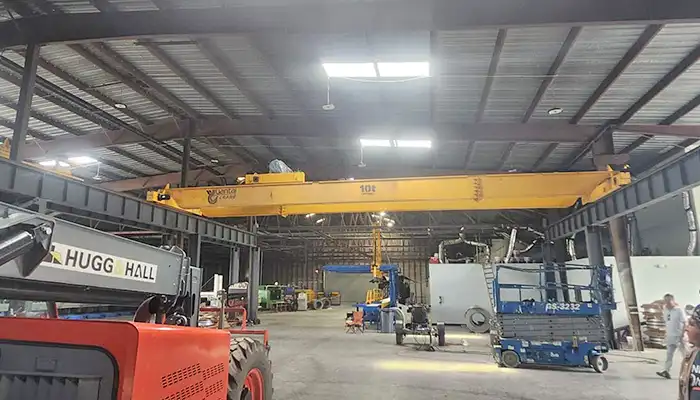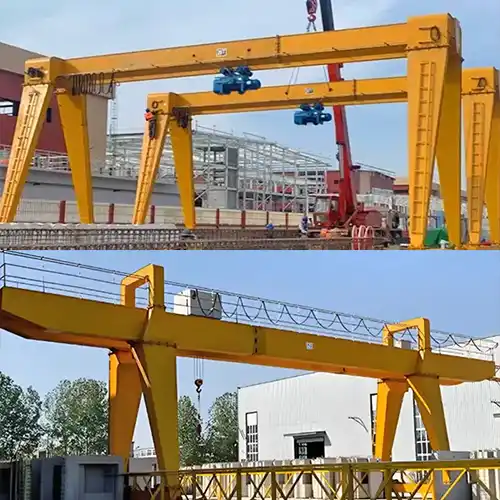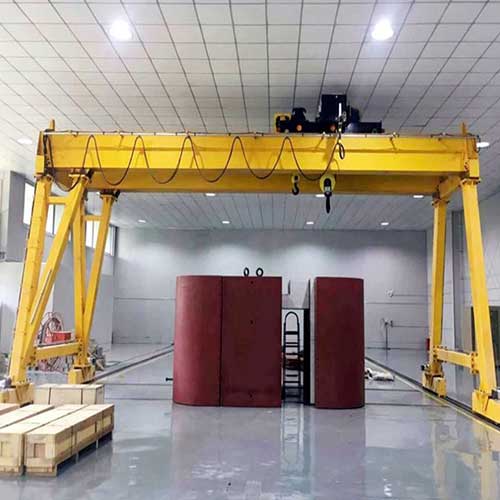Outdoor Gantry Cranes 20 Ton: Types & Outdoor Considerations
20 ton outdoor gantry cranes, including single vs. double girder, rail-mounted vs. rubber-tyred, weatherproofing, and key industrial applications.
Category: 20 Ton Gantry Crane
Your Trusted 20 Ton Gantry Crane Manufacturer & Supplier
20 Ton Gantry Crane for Sale
Outdoor Gantry Cranes 20-Ton : Types, Designs, and Environmental Considerations
Learn about 20-ton outdoor gantry cranes, including single vs. double girder, rail-mounted vs. rubber-tyred, weatherproofing, and key industrial applications.
Outdoor gantry cranes are a cornerstone in many heavy-duty industrial operations. Unlike indoor cranes, these cranes are designed to handle tough environmental conditions while moving heavy loads efficiently across open spaces. From metal yards to shipping docks, outdoor gantry cranes provide reliable lifting solutions where other cranes simply can't be installed.
For many companies, a 20-ton capacity crane strikes the perfect balance. It's heavy enough to handle large bundles of steel, concrete components, or machinery parts, yet compact enough to remain flexible and easier to maintain than bigger, more complex cranes. This makes it a popular choice for both medium-sized plants and large-scale industrial sites.
Advantages of 20-Ton Capacity for Outdoor Operations
A 20-ton outdoor gantry crane offers several practical benefits:
- Versatile Load Handling: Capable of lifting steel billets, concrete precast elements, heavy machinery, and large containers without needing multiple cranes.
- Cost-Effective: Compared to larger cranes, a 20-ton model often requires less foundation work, consumes less power, and has lower maintenance costs.
- Flexibility in Placement: Can be installed on rails or made mobile with rubber tires, allowing you to move the crane to different parts of a yard as needed.
- Reliable Performance in Outdoor Conditions: Designed to withstand wind, rain, dust, and even coastal corrosion when properly weatherproofed.
Common Industries and Applications for Outdoor 20-Ton Gantry Cranes
20-ton outdoor gantry cranes are widely used across several industries where heavy materials need to be moved outdoors efficiently:
- Steel and Metal Industries: Moving slabs, coils, beams, and other heavy metal products within storage yards or between production areas.
- Construction and Precast Concrete: Lifting large concrete blocks, bridge segments, and precast panels at construction sites or storage facilities.
- Ports and Shipping Yards: Handling containers, cargo bundles, and heavy equipment in docks and freight yards.
- Power Plants and Industrial Equipment Yards: Moving turbines, generators, transformers, and other large components during installation or maintenance.
- Manufacturing and Warehousing: Outdoor storage areas for oversized machinery parts or raw materials that need regular lifting.
In short, a 20-ton outdoor gantry crane is practical, adaptable, and suited for industries where heavy lifting outdoors is a daily requirement. Its combination of capacity, durability, and flexibility makes it a solid investment for almost any operation that deals with large loads.
Typical Types of 20-Ton Outdoor Gantry Cranes
When selecting an outdoor gantry crane 20 ton, it's important to understand the main types available. For this capacity, the most common choices are 20 ton gantry crane single girder and 20 ton gantry crane double girder. Each type has distinct advantages depending on your site layout, load requirements, and environmental conditions. Check the 20 ton gantry crane single girder vs. double girder design, and contact us to get your customized 20 ton material handling solution.
20 Ton Gantry Crane Single Girder
A 20 ton gantry crane single girder features one main beam supported by end frames that can travel on rails or wheels. The hoist runs on top of this single girder. This simple design makes the crane lighter and easier to install, which is especially useful for outdoor yards where space and foundation work may be limited. 20 ton gantry crane for sale USA, a case for your reference.

Typical Span and Lifting Height
- Span: Usually ranges from 10 to 30 meters, customizable to your site.
- Lifting Height: Typically between 6 to 12 meters, depending on load type and ground clearance.
Pros and Cons for Outdoor Use
Pros:
- Cost-effective solution for outdoor lifting
- Lighter structure requires simpler foundations
- Easier and faster installation, ideal for temporary or semi-permanent outdoor setups
Cons:
- Limited lifting height for very tall loads
- Less rigid than double girder cranes, may sway slightly in windy conditions
- Not ideal for extremely heavy or high-frequency outdoor lifting
20 Ton Gantry Crane Double Girder
Structural Features and Strength Advantages
The 20 ton gantry crane double girder has two main girders with the hoist traveling between them. This design allows for higher lifting heights and better load distribution. It is more rigid, offering stability and durability for demanding outdoor operations.

Heavy-Duty Outdoor Applications
- Handling steel slabs, coils, or large machinery in storage yards
- Lifting shipping containers in ports or freight yards
- Frequent outdoor lifting cycles where high stability and performance are required
Pros and Cons Compared to Single Girder
Pros:
- Higher lifting height and better load handling
- More stable under heavy loads and outdoor wind conditions
- Suited for long-term use and demanding outdoor operations
Cons:
- Higher cost than single girder cranes
- Heavier structure requires stronger foundations
- More complex installation and maintenance
Non-Rail vs. Rail Traveling Outdoor Gantry Cranes 20 Ton
When choosing an outdoor gantry crane 20 ton, one of the main decisions is whether to go with a rubber tyred gantry crane 20 ton (mobile) or a rail mounted gantry crane 20 ton. Both types can handle the full 20-ton capacity, but each has distinct advantages depending on site layout, load movement patterns, and operational needs.

Rubber Tyred A Frame Gantry Crane 20 Ton (Mobile)
Structure and Features:
- Moves on rubber tires, providing full mobility across outdoor yards without rails.
- Available in both single girder and double girder designs for 20-ton lifting.
- Can be powered by electricity or diesel, depending on site conditions.
Applications of Rubber Tyred Gantry Crane 20 Ton:
- Outdoor storage yards with flexible layouts
- Construction sites needing temporary lifting solutions
- Freight yards where multiple lifting positions are required
Advantages:
- Highly flexible and easy to relocate as needed
- No need for permanent rail infrastructure
- Suitable for outdoor sites with multiple lifting points or changing layouts
Limitations:
- Less precise movement compared to rail-mounted cranes
- Stability may be affected on uneven ground
- Travel speed may be slower under full 20-ton loads

Rail Mounted Gantry Crane 20 Ton
Structure and Features:
- Fixed to rails, offering a stable and precise lifting path for the outdoor gantry crane 20 ton.
- Supports both single girder and double girder configurations for 20-ton loads.
- Ideal for repetitive lifting operations along fixed routes.
Applications of Rail Mounted Gantry Crane 20 Ton:
- Ports and shipping terminals for container handling
- Steel or metal yards with fixed storage lanes
- Industrial yards with repetitive heavy lifting tasks
Advantages:
- Stable and precise load positioning
- Handles frequent lifting cycles with minimal wear
- Suited for heavy-duty outdoor operations such as steel yards and ports
Limitations:
- Less flexible; movement is restricted to the rail line
- Requires rail installation and foundation work
- Relocation is more complicated and costly
Choosing the right type of outdoor gantry crane 20 ton depends on whether your priority is mobility or precision. A rubber tyred gantry crane 20 ton works best for flexible sites, while a rail mounted gantry crane 20 ton is ideal for fixed routes and heavy-duty operations.
Outdoor Gantry Crane 20 Ton: Weatherproofing and Environmental Considerations
Operating a 20 ton outdoor gantry crane comes with unique environmental challenges. Unlike indoor cranes, outdoor cranes face exposure to wind, rain, dust, and sometimes corrosive conditions. Addressing these factors during selection, installation, and maintenance is crucial to ensure safe and reliable operations.
Environmental Challenges: Coastal Areas – Salt Corrosion and Humidity
Salt-laden air can accelerate corrosion on steel structures and exposed metal parts. High humidity can affect electrical components and reduce lifespan if not properly protected.
Environmental Challenges: Dusty or Sandy Environments – Abrasion
Outdoor yards near quarries, deserts, or open storage areas can generate abrasive dust and sand. Dust accumulation can affect gears, hoists, and trolleys, increasing wear and maintenance needs.
Environmental Challenges: High-Wind or Storm-Prone Areas
Wind can cause sway in single girder cranes or mobile cranes, affecting load stability. Storms or sudden gusts require wind sensors or operational safety protocols.
Environmental Challenges: Rain and Snow Exposure
Water ingress can damage electrical panels and reduce mechanical efficiency. Snow and ice can create slippery conditions on tracks or wheels, requiring winter-specific precautions.
Materials and Coatings: Galvanized Steel or Weather-Resistant Paints
Provides a basic layer of corrosion protection for the crane structure.
Materials and Coatings: Powder Coating and Anti-Corrosion Treatments
Offers long-term durability in harsh outdoor conditions. Especially important for cranes exposed to coastal or industrial pollutants.
Materials and Coatings: Stainless Steel Components for Critical Parts
Use for trolley wheels, hoist drums, electrical enclosures, or control panels where corrosion risk is high.
Optional Features for Durability
- Sealed Electrical Enclosures: Prevent moisture and dust from affecting control systems.
- IP-Rated Motors and Hoists: Ensure lifting mechanisms are protected from water and dust ingress.
- Protective Covers for Trolleys and Hoists: Shield moving parts from debris and weather exposure.
- Wind Sensors and Overload Protection: Automatically stop crane operation during unsafe conditions to prevent accidents.
Maintenance Recommendations
- Regular Lubrication and Inspection: Keep gears, wheels, and hoist mechanisms properly lubricated to prevent wear from dust or moisture.
- Seasonal Checks for Corrosion or Structural Integrity: Inspect frames, end supports, and joints for rust or damage, especially after winter or storm seasons.
- Electrical System Maintenance: Check wiring, motors, and control panels regularly to ensure outdoor exposure hasn't caused insulation or connection issues.
Why Address Environmental and Weatherproofing Needs?
For any outdoor gantry crane 20 ton, addressing environmental and weatherproofing needs upfront can prevent costly repairs, downtime, and safety risks. Choosing the right materials, protective coatings, and optional durability features ensures reliable performance in almost any outdoor condition.
Specialized Features and Tailored Options for 20 Ton Outdoor Gantry Cranes
A 20 ton outdoor gantry crane can be customized with specialized features to handle different types of loads efficiently and safely. Understanding the nature of the materials and operational requirements helps determine which features are essential.
Common Load Types for 20-Ton Outdoor Gantry Cranes
- Steel Billets, Rebar Bundles, Slabs: Heavy, dense, and often irregularly shaped materials that require clamps, magnets, or grabs for secure lifting.
- Heavy Machinery Components: Large and awkward loads, often requiring spreader beams or multiple hoist attachments to maintain balance.
- Shipping Containers: Standardized but very heavy; container spreaders and double hoist systems are common for safe handling.
Load Distribution Considerations
- Ensure that loads are evenly distributed across the crane girder to prevent structural stress.
- For asymmetrical or off-center loads, consider specialized lifting attachments or multiple hoists.
- Verify ground conditions for mobile cranes to prevent tipping or uneven lifting.
Safety Factors and Recommended Lifting Margins
- Always include a 10–20% safety margin over the maximum expected load.
- Overload sensors and limit switches should be installed to prevent accidents.
- Wind, rain, and other environmental conditions should be factored into load limits for outdoor cranes.
Frequency of Use and Duty Cycles
- Light-duty cranes may handle occasional lifting a few times per day.
- Medium to heavy-duty cranes should be rated for frequent or continuous outdoor operations.
- The crane's mechanical and electrical components should match expected duty cycles to minimize wear and maintenance needs.
Industrial Sectors and Applications
A 20 ton outdoor gantry crane finds applications across many industries where heavy lifting outdoors is required. Here are the typical sectors and uses:
Steel and Metal Industry
- Moving steel slabs, coils, billets, and fabricated parts in open storage yards or production areas.
- Optional features: magnetic lifters, slab clamps, and double hoist systems for uneven loads.
Construction and Civil Engineering
- Handling large precast concrete panels, bridge segments, and other structural components.
- Optional features: grabs, spreaders, and adjustable lifting heights for oversized loads.
Ports, Shipping, and Logistics
- Loading and unloading containers, cargo bundles, and heavy machinery in freight yards or docks.
- Optional features: container spreaders, double hoists, and rail-mounted configurations for precision.
Power Plants and Heavy Machinery Yards
- Moving turbines, generators, transformers, and other large equipment during installation or maintenance.
- Optional features: heavy-duty double girder frames, wind sensors, and hoist overload protection.
Warehousing for Oversized Items
- Outdoor storage areas that require lifting and repositioning of oversized machinery, molds, or materials.
- Optional features: mobile rubber-tyred cranes for flexible yard movement and customized lifting attachments.
Practical Takeaway: A 20 ton outdoor gantry crane can be tailored to handle specific loads safely and efficiently. By matching lifting accessories, duty cycles, and mobility options to your industry and material types, you ensure maximum productivity and long-term reliability in outdoor operations.
Key Buying and Operational Considerations for Outdoor Gantry Crane 20 Ton
Investing in a 20 ton outdoor gantry crane is a major decision. Choosing the right crane ensures safety, efficiency, and long-term reliability in outdoor operations. Several factors must be considered before making a purchase.
Selecting the Right Type: Single vs. Double Girder, Mobile vs. Rail-Mounted
- Single Girder: Best for moderate-duty lifting and shorter spans. Cost-effective, lighter, and easier to install.
- Double Girder: Ideal for heavy-duty, high-frequency operations or taller lifting heights. Provides better stability and load handling.
- Mobile Rubber Tyred Crane 20 Ton: Offers flexibility for moving loads across outdoor yards without rails. Suitable for sites with changing layouts.
- Rail Mounted Gantry Crane 20 Ton: Fixed rails provide precise load movement along defined paths, perfect for ports, steel yards, and repetitive lifting tasks.
Duty Classification and Load Frequency
- Light-duty cranes handle occasional lifting and are sufficient for smaller outdoor operations.
- Medium to heavy-duty cranes are designed for frequent lifting cycles.
- Ensure the crane's mechanical and electrical systems match your expected duty cycle to prevent premature wear.
Span, Height, and Site Layout Requirements
- Determine the required span to cover your yard or operational area efficiently.
- Lifting height should accommodate the tallest load or the highest stacking requirement.
- Consider site layout: clearances, obstacles, ground conditions, and movement paths for mobile or rail-mounted cranes.
Power Supply and Control System Considerations
- Verify compatibility with local power sources: single-phase, three-phase, or high-voltage options.
- Control systems may include pendant controls, radio remote controls, or cabin-mounted systems depending on operational needs.
- Ensure wiring, transformers, and protective devices are rated for outdoor exposure.
Environmental and Weatherproofing Needs
- Coastal, dusty, or high-wind areas require corrosion-resistant materials and protective coatings.
- IP-rated motors, sealed electrical enclosures, and protective covers for hoists and trolleys extend service life.
- Optional features like wind sensors and overload protection improve operational safety in outdoor conditions.
Safety Features and Compliance with Standards (ISO, CE)
- Look for cranes that meet recognized safety standards (ISO, CE) for outdoor operations.
- Safety devices include overload limiters, emergency stop functions, end-stop bumpers, and anti-sway mechanisms.
- Regular inspections and preventive maintenance are essential for safe and reliable crane performance.
Practical Takeaway
A well-chosen outdoor gantry crane 20 ton balances capacity, durability, and operational flexibility. By carefully considering type, duty, site layout, power, environmental factors, and safety features, buyers can ensure efficient lifting operations and long-term reliability.
Installation and Setup for Outdoor Gantry Cranes 20 Ton
Installing a 20 ton outdoor gantry crane requires careful planning to ensure safety, stability, and efficient operation. Proper site preparation, assembly, and commissioning are critical, especially for cranes exposed to outdoor conditions. Each step impacts the crane's long-term performance and reliability.
Site Preparation: Foundations, Rails, or Pad Requirements
- Rail-Mounted Gantry Cranes 20 Ton: Require strong, level rails with properly designed foundations capable of supporting the maximum load plus safety margins. Proper alignment is crucial to prevent uneven travel or structural stress.
- Rubber Tyred Gantry Crane 20 Ton: Needs a stable, level pad with sufficient load-bearing capacity. Concrete pads or compacted surfaces help prevent sinking, tipping, or uneven movement.
- Drainage and Ground Conditions: Outdoor sites should be prepared to handle rainwater, snow, or ice. Poor drainage can negatively affect crane stability and mobility.
Proper site preparation ensures the crane operates safely and efficiently from day one, reducing long-term maintenance issues.
Assembly Procedures for Outdoor Conditions
- Step-by-Step Assembly: Begin with end frames, then install the main girders, followed by the hoist and trolley system.
- Weather Considerations: Avoid assembly during heavy rain, strong winds, or icy conditions. Temporary covers can protect crane components during installation.
- Cranes with Modular Designs: Some outdoor gantry cranes come in pre-fabricated sections for easier on-site assembly, reducing installation time and complexity.
Following proper assembly procedures reduces the risk of operational issues and ensures that the crane functions safely once commissioned.
Electrical and Control System Integration
- Ensure electrical supply matches crane specifications, including voltage, phase, and frequency.
- Outdoor-rated cables, conduits, and IP-protected enclosures help prevent moisture and dust from affecting the system.
- Install control systems—pendant, remote, or cabin controls—based on operator access and site layout.
- Test grounding, surge protection, and emergency stop circuits thoroughly before operation.
Correct electrical integration is essential for safety and efficiency, especially in outdoor conditions where exposure to moisture, dust, and temperature fluctuations can impact performance.
Testing and Commissioning for Outdoor Operations
- No-Load Test: Verify smooth travel along rails or pads, hoist movement, and trolley operation.
- Load Test: Gradually lift rated loads to confirm stability, braking, and proper load distribution.
- Safety Checks: Inspect limit switches, overload sensors, wind sensors, and other safety devices.
- Final Adjustments: Make necessary alignment or tension adjustments to ensure smooth, precise, and safe operation under outdoor conditions.
Comprehensive testing ensures that the 20 ton outdoor gantry crane will operate safely and reliably, reducing the risk of downtime and accidents during actual lifting operations.
Conclusion
Selecting the right 20 ton outdoor gantry crane requires understanding the available types, designs, and their applications. Each crane type offers specific advantages depending on the lifting requirements, frequency of use, and outdoor conditions.
Types of 20 Ton Outdoor Gantry Cranes
When choosing a crane, it's important to consider the structural design and mobility options. Key types include:
- Single Girder: Cost-effective, ideal for moderate-duty lifts and shorter spans.
- Double Girder: Provides higher lifting heights, better stability, and is suitable for heavy or frequent operations.
- Rubber Tyred Crane 20 Ton: Mobile and flexible, perfect for yards with changing layouts.
- Rail Mounted Gantry Crane 20 Ton: Offers precise, repeatable movement along fixed paths, ideal for ports or steel yards.
Choosing the appropriate type ensures that the crane fits the operational needs, maximizes efficiency, and minimizes risks during outdoor lifting operations.
Environmental Considerations and Maintenance
Operating a crane outdoors exposes it to weather, dust, and corrosion, which can affect safety and performance. Important factors include:
- Protective coatings, galvanized or stainless steel components to prevent corrosion.
- IP-rated motors, sealed electrical enclosures, and protective covers for hoists and trolleys.
- Regular maintenance: lubrication, structural inspections, and electrical system checks.
Implementing these measures ensures long-term reliability, reduces downtime, and maintains safe operation under harsh outdoor conditions.
Industrial Applications and Recommendations
Different industries have unique lifting needs, and the crane must be tailored accordingly. Typical applications include:
- Steel and Metal Yards: Handling slabs, coils, billets – often requiring slab clamps or magnetic lifters.
- Construction: Precast concrete panels and bridge components – adjustable hoists and grab attachments improve flexibility.
- Ports and Logistics: Container handling and cargo loading – rail-mounted cranes with spreaders offer precision.
- Power Plants and Machinery Yards: Moving heavy equipment – double girder cranes with overload protection are recommended.
By matching the crane design, mobility, and features to the industry, load type, and lifting frequency, operators can achieve efficient, safe, and reliable performance in any outdoor environment.
Related Products

Affordable 10 ton double girder overhead crane with CD/MD hoist trolley, built for U.S. standards, ideal for construction and industrial lifting
Free consultation to Confirm Parameters & Specifications and Get
Latest Crane Price & Crane Rate.
- Types of overhead cranes : _______?
- Optional: Overhead travelling crane, goliath gantry crane,Slewing jib crane, Single girder or double girder crane,small portable crane or kbk crane, etc.
- Capacity of overhead crane: _______?
- Optional: 0.25ton, 0.5 ton, 1 ton, 2 ton, 3ton, 5 ton, 10 ton,15ton, 20ton, 25 ton, 30ton,35ton, up to 550ton, etc.
- Crane span & lifting height : _______?
- Crane travelling length : _____?
- Control of overhead crane:_______?
- Optional: pendant/ remote/cabin control
- Voltage supply of overhead crane:_____?
- Eg,: 380V50/60HZ,3Phase or others,etc.
- Application/usage of crane:_______?
- Eg,: Steel mill, ,injection mold, cement,stone, concrete,granite, general manufacturing, etc.
Just leave a message via the contact form and our hoist and crane engineer will contact you with in 24working hours.
Get In Touch


